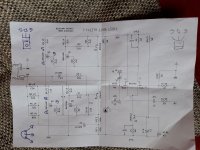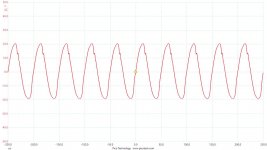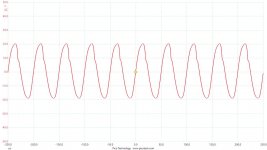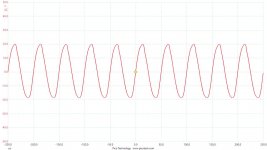yes, everything is identical except for Jfet. All voltages are good, 1A bias. The test is done with the negative IN attached to the GND
Thanks for the idea.
Tell me, how to put a trimmer (pot) on the board instead of a constant resistor 1/4 W? Perhaps there is a solution similar to yours.
Perhaps there are transition panels. Help solve the puzzle.
Try soldering some resistor clippings to the legs to extend them and insert into resistor position. Or attach small gauge wires.
TJ
I have made a few changes and the auto oscillation disappeared. (see diagram). However, it does not seem normal, something is wrong, it has to work perfectly according to the original scheme without any "improvements".
I eliminated the effect but not the cause. Maybe we can find the reason together. Merci!
I eliminated the effect but not the cause. Maybe we can find the reason together. Merci!
Attachments
we can't find reason without all proper info - which includes pictures of your build
however , find enclosed more or less reference Aleph amp file , where you can see notes for most interesting positions and also few cap positions ( look for 1nF) , exactly for taming possible oscillations
however , find enclosed more or less reference Aleph amp file , where you can see notes for most interesting positions and also few cap positions ( look for 1nF) , exactly for taming possible oscillations
Attachments
I would first try adding the 1 nF capacitors Zen Mod mentioned, as per the schematic compiled by Algar_emi.
Then, before modifying anything more, please try your Aleph J with "the standard First Watt PSU" instead of your lab supplies.
I had some pretty funky effects when I was building my Aleph Mini / J and was trying it with my regulated lab supplies. I didn't understand what was going on and was beginning to tear my hair out about the lack of stability ... until I tried it with the "real" PSU. Now the amp behaved as expected and was completely stable.
Still don't know what it was with the lab supplies, maybe something to do with the regulation interfering with the amp ...
So, when you have connected your boards to a "proper" PSU, and it is stable, try reversing your mods, while leaving the 1 nF caps in that are shown in Algar_emi's schematic.
Best regards,
Claas
Then, before modifying anything more, please try your Aleph J with "the standard First Watt PSU" instead of your lab supplies.
I had some pretty funky effects when I was building my Aleph Mini / J and was trying it with my regulated lab supplies. I didn't understand what was going on and was beginning to tear my hair out about the lack of stability ... until I tried it with the "real" PSU. Now the amp behaved as expected and was completely stable.
Still don't know what it was with the lab supplies, maybe something to do with the regulation interfering with the amp ...
So, when you have connected your boards to a "proper" PSU, and it is stable, try reversing your mods, while leaving the 1 nF caps in that are shown in Algar_emi's schematic.
Best regards,
Claas
not well behaving labb supply is either inadvertently left too low current limit , or simply - basket case lab supply (utter drek , in other words)


Any luck Niculian? Looks like tuning a transmitter with the varicap ..
Well I think I am going to give up. Mine is also unstable, there are oscillations/distortion especially when driving 10-15W and lower freq are better than the higher frequencies, output is in 8R resistor.
Added the 2 1nF caps, but not much of a difference. pics: 20KHz 15W into 8R dummyload, with 2 1 and no 1nF.
Well I think I am going to give up. Mine is also unstable, there are oscillations/distortion especially when driving 10-15W and lower freq are better than the higher frequencies, output is in 8R resistor.
Added the 2 1nF caps, but not much of a difference. pics: 20KHz 15W into 8R dummyload, with 2 1 and no 1nF.
Attachments
Hello everyone!
I am a new solid state amp builder (I've done many tube amps) and am starting to build out the Aleph J now as monoblocks with two separate chassis. I am using the diyaudio store PSU board v3.0. I have purchased two of the boards, all parts to populate them (16 caps total), 4 bridge rectifiers and two Antek transformers. (the 5218) This is all very new to me. Do I understand correctly that it will work to build the same power supply as for the stereo version that 6L6 showed in the beginning of the thread but only hook up one channel? From the photos, it looks to me like each channel in the stereo version just shares the same take off points on the PSU. Thanks much for any help!
I am a new solid state amp builder (I've done many tube amps) and am starting to build out the Aleph J now as monoblocks with two separate chassis. I am using the diyaudio store PSU board v3.0. I have purchased two of the boards, all parts to populate them (16 caps total), 4 bridge rectifiers and two Antek transformers. (the 5218) This is all very new to me. Do I understand correctly that it will work to build the same power supply as for the stereo version that 6L6 showed in the beginning of the thread but only hook up one channel? From the photos, it looks to me like each channel in the stereo version just shares the same take off points on the PSU. Thanks much for any help!
Hello! I was wondering - do I understand correctly that Q5/Q6 should be matched and Q7/Q8 should be matched but no need to match Q5/Q6 to Q7/Q8? Somewhere in the thread it said match uppers and lowers but not necessary to eachother and that is how I interepreted that.
Well, I've been working on my boards as snippets of time present themselves.
In review, my 1rst board didn't work out. Had .950v across R18 that wouldn't respond to R27 adjustment, a whopping 16.3v DC offset.
Pulled board #1 twice to check components placement and orientation, reflow all joints and thoroughly clean to no avail.
Went ahead and built board #2 as I did (or attempted to) #1 by the numbers of the build guide. Compared it carefully to board #1 and found no diferences.
Installed board #2 into the chassis, powered it up. Was able to adjust R27 to .350v across R18, DC offset was .007. Put the top on, 1/2 hour later adjusted R27 to .40v across R18, adjusted R7 to .000 DC offset. Q5,6,7,8 temps ranged from 103F to 106F.
Input Spotify via my iPhone to a test speaker and it has never sounded sounded so good. Played it for an hour making clean, sweet music.
Go figure.
So, I've got a nice mono Aleph J. For now I'm calling this a learning experience and will proceed with the M2x/Norwood boards and see if I can get a stereo amplifier going.
In review, my 1rst board didn't work out. Had .950v across R18 that wouldn't respond to R27 adjustment, a whopping 16.3v DC offset.
Pulled board #1 twice to check components placement and orientation, reflow all joints and thoroughly clean to no avail.
Went ahead and built board #2 as I did (or attempted to) #1 by the numbers of the build guide. Compared it carefully to board #1 and found no diferences.
Installed board #2 into the chassis, powered it up. Was able to adjust R27 to .350v across R18, DC offset was .007. Put the top on, 1/2 hour later adjusted R27 to .40v across R18, adjusted R7 to .000 DC offset. Q5,6,7,8 temps ranged from 103F to 106F.
Input Spotify via my iPhone to a test speaker and it has never sounded sounded so good. Played it for an hour making clean, sweet music.
Go figure.
So, I've got a nice mono Aleph J. For now I'm calling this a learning experience and will proceed with the M2x/Norwood boards and see if I can get a stereo amplifier going.
Well, I've been working on my boards as snippets of time present themselves.
In review, my 1rst board didn't work out. Had .950v across R18 that wouldn't respond to R27 adjustment, a whopping 16.3v DC offset.
Pulled board #1 twice to check components placement and orientation, reflow all joints and thoroughly clean to no avail.
Went ahead and built board #2 as I did (or attempted to) #1 by the numbers of the build guide. Compared it carefully to board #1 and found no diferences.
Installed board #2 into the chassis, powered it up. Was able to adjust R27 to .350v across R18, DC offset was .007. Put the top on, 1/2 hour later adjusted R27 to .40v across R18, adjusted R7 to .000 DC offset. Q5,6,7,8 temps ranged from 103F to 106F.
Input Spotify via my iPhone to a test speaker and it has never sounded sounded so good. Played it for an hour making clean, sweet music.
Go figure.
So, I've got a nice mono Aleph J. For now I'm calling this a learning experience and will proceed with the M2x/Norwood boards and see if I can get a stereo amplifier going.
I would just chase down the bad board. AlephJ is an amp you WILL want.
One board is good, so either there is a build error, or failed component. You may have already, but make sure no continuity as far as output pads and mosfets and heatsink. Post clear pics of bad board and someone will be along to chase down the problem.
As you can see from the good board, it is a very simple amp, just a minor problem somewhere.
Russellc
Last edited:
Did the post pics things and followed up on received suggestions earlier in the thread, including checking for continuity between mosfets' pins and the heat sink at the mounting screw.
I'm leaning toward a failed component(or components) at this point, but my electronics skills are limited so I lack confidence in my ability to perform that kind of troubleshooting. Not abandoning the Aleph J amp boards completely, but the $ investment in chassis and power supply and the wonderful noise from board #2 are motivating me to get something working and into my system.
Looking to get by and wind up with something wonderful by closely following instructions given and be able to take some satisfaction of having been part of it all beyond just writing a check and hooking something up.
Here's hoping I have better luck with my next project.
I'm leaning toward a failed component(or components) at this point, but my electronics skills are limited so I lack confidence in my ability to perform that kind of troubleshooting. Not abandoning the Aleph J amp boards completely, but the $ investment in chassis and power supply and the wonderful noise from board #2 are motivating me to get something working and into my system.
Looking to get by and wind up with something wonderful by closely following instructions given and be able to take some satisfaction of having been part of it all beyond just writing a check and hooking something up.
Here's hoping I have better luck with my next project.
That's unfortunate. AlephJ is one of the best. I would encourage a rebuild of bad channel. Testing Jfets first. If they are ok, the rest is easy and cheap.
That one working channel isn't lying, it's a great amp and worth the effort.
Russellc
That one working channel isn't lying, it's a great amp and worth the effort.
Russellc
I would just chase down the bad board.
Russellc
You're right, change of plan.
I'm going to see what I can learn about testing mos/j fets before moving on.
You're right, change of plan.
I'm going to see what I can learn about testing mos/j fets before moving on.
I'm glad. Don't get me wrong, M2 is really nice too, but AlephJ is a lovely amp! Single ended with all that, but hooked up to the Econwaves in TV room, will shake the house. Delightfully fun to listen to. And you are half way there!
- Home
- Amplifiers
- Pass Labs
- Aleph J illustrated build guide




